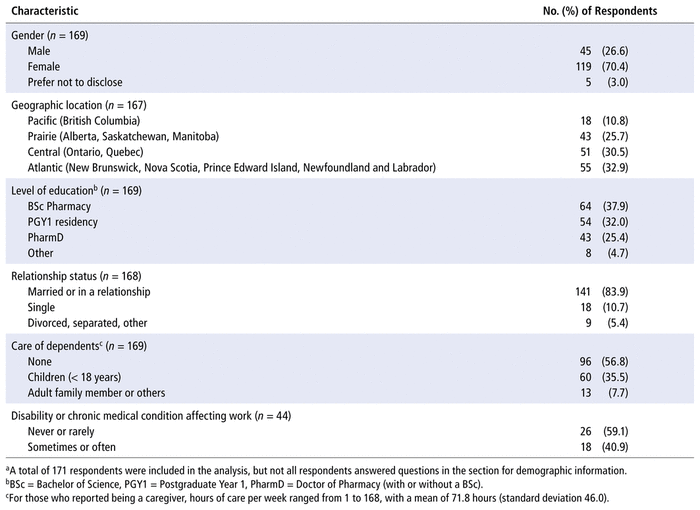
Courtney L Blue, Odette N Gould, Corry Clarke, Heather Naylor, Meghan MacKenzie, Sarah Burgess, Stacey MacAulay, Andrew J FlewellingABSTRACT
Background
Burnout is a growing problem among health care professionals, with consequences for patient safety and personal satisfaction. The prevalence of burnout among hospital pharmacists in Canada is unknown; however, it has been documented at over 60% in other countries.
Objectives
To assess the prevalence of burnout and variables associated with burnout among hospital pharmacists in Canada.
Methods
This cross-sectional cohort study was based on a survey made available to more than 2600 Canadian hospital pharmacists from February 10 to April 2, 2020, through the Canadian Society of Hospital Pharmacists QID platform. The questionnaire collected data for the Maslach Burnout Inventory Human Services Survey for Medical Personnel (MBI-HSSMP), demographic data, employment characteristics, and workplace factors; it also included an open-ended question about burnout.
Results
A total of 171 respondents provided data suitable for analysis. Of these, only 13 (7.6%) met the criteria for burnout on all 3 subscales of the burnout inventory; however, 105 respondents (61.4%) surpassed the threshold for burnout on the emotional exhaustion subscale. In univariate analyses, not working to one’s full scope of practice was associated with meeting the criteria for burnout on all 3 scales. Linear regression highlighted associations between scores on the emotional exhaustion subscale and gender identity, perceived excessive on-call duties, area of practice, and positivity of workplace culture. Content analysis of the open-ended question supported the quantitative findings and pointed to 3 major themes: workload quantity, workload quality, and workplace culture.
Conclusions
Results on the emotional exhaustion subscale of the MBI-HSSMP and responses to the open-ended question suggested a relatively high prevalence of burnout among Canadian hospital pharmacists, and indicated potential links between burnout and certain workplace characteristics.
KEYWORDS: burnout, pharmacists, hospital pharmacy, emotional exhaustion
RÉSUMÉ
Contexte
L’épuisement professionnel est un problème croissant chez les professionnels de la santé qui entraîne des conséquences sur la sécurité des patients et la satisfaction personnelle des professionnels. La prévalence de l’épuisement professionnel chez les pharmaciens d’hôpitaux au Canada est inconnue; cependant, il a été documenté à plus de 60 % dans d’autres pays.
Objectifs
Évaluer la prévalence de l’épuisement professionnel et les variables associées à celui-ci chez les pharmaciens d’hôpitaux au Canada.
Méthodes
Cette étude de cohorte transversale se basait sur un sondage distribué à plus de 2600 pharmaciens d’hôpitaux canadiens entre le 10 février et le 2 avril 2020 via la plateforme QID de la Société canadienne des pharmaciens d’hôpitaux. Le questionnaire a permis de recueillir des données pour le Maslach Burnout Inventory Human Services Survey for Medical Personnel (MBI-HSSMP; un inventaire de l’épuisement professionnel chez les professionnels de la santé), des données démographiques, des caractéristiques professionnelles et des facteurs liés au lieu de travail; il comprenait également une question ouverte sur l’épuisement professionnel.
Résultats
Au total, 171 répondants ont fourni des données se prêtant à l’analyse. Parmi ceux-ci, seuls 13 (7,6 %) répondaient aux critères de l’épuisement professionnel des 3 sous-échelles de l’inventaire de l’épuisement professionnel; cependant, 105 répondants (61,4 %) ont dépassé le seuil d’épuisement professionnel de la sous-échelle d’épuisement émotionnel. Dans les analyses univariées, le fait de ne pas travailler dans l’ensemble de son champ d’exercice était associé au respect des critères d’épuisement professionnel sur les 3 sous-échelles. La régression linéaire a mis en évidence des associations entre les scores sur la sous-échelle d’épuisement émotionnel et l’identité de genre, les tâches de garde excessives perçues, le domaine de pratique et la positivité de la culture sur le lieu de travail. L’analyse du contenu de la question ouverte étayait les résultats quantitatifs et a souligné 3 thèmes principaux : la quantité et la qualité de la charge de travail, ainsi que la culture sur le lieu de travail.
Conclusions
Les résultats relatifs à la sous-échelle d’épuisement émotionnel du MBI-HSSMP et les réponses à la question ouverte suggèrent une prévalence relativement élevée d’épuisement professionnel chez les pharmaciens d’hôpitaux canadiens et indiquent des liens potentiels entre l’épuisement professionnel et certaines caractéristiques du milieu de travail.
MOTS CLÉS: épuisement professionnel, burnout, pharmaciens, pharmacie hospitalière, épuisement émotionnel
Burnout is defined as a “syndrome of emotional exhaustion, depersonalization, and reduced personal accomplishment that can occur among individuals who work with other people in some capacity” (p. 192).1 Health care provider burnout and its association with negative outcomes has been confirmed in many health care professions, including pharmacy.2–5
Negative outcomes identified have included decreased quality of patient care,6–8 decreased personal satisfaction,5,9 increased medical errors,8,10 and increased anticipated job turnover,8,9 thus highlighting the potential of burnout to affect patient safety. Many variables have been specifically associated with burnout in pharmacists, including age, gender, years practising as a pharmacist, marital status, inadequate administrative and teaching time, too many nonclinical duties, difficult colleagues, and feelings that contributions are underappreciated.3,8,11–13 Given the nature of burnout, it is not surprising that it has been positively correlated with anticipated job turnover; the implications of job turnover include compromised quality of care and financial consequences (e.g., cost to recruit new employees, costs associated with lower productivity of new hires).9,14
The percentage of hospital pharmacists in the United States,3 Japan,15 and Ontario (Canada)12 who experience burnout has been documented at over 60%. There are also indications that rates of burnout have increased during the COVID-19 pandemic in Australia16 and in the United States.17 The primary objective of the present project was to identify the prevalence of burnout among hospital pharmacists across Canada. The secondary objective was to identify variables associated with burnout.
This study involved a cross-sectional cohort survey of Canadian hospital pharmacists who had been practising for 1 year or more; pharmacy residents were excluded. The study was approved by the New Brunswick Horizon Health Network Research Ethics Board (file number 2019–2817). Potential participants first read the information about the study and indicated informed consent by choosing to answer the survey.
The 48-question survey consisted of 5 sections: the Maslach Burnout Inventory Human Services Survey for Medical Personnel (MBI-HSSMP), demographic information, employment characteristics, workplace factors, and an open-ended question about burnout.
The MBI-HSSMP is a tool consisting of 22 standardized questions used to investigate burnout syndrome among respondents, for which both validity and reliability have been established for medical personnel, including pharmacists.18,19 A licence was obtained from Mind Garden, Inc, to use the MBI-HSSMP for this study. The MBI-HSSMP20 is divided into 3 subscales—emotional exhaustion, depersonalization, and personal accomplishment—with 9, 5, and 8 statements, respectively.20 For each statement, respondents are asked to describe their frequency of the feeling on a 7-point Likert scale ranging from 0 (never) to 6 (every day).20 Scores were summed for each subscale, and a level of burnout—high, moderate, or low—was assigned according to the numeric score.
Two approaches were used to define burnout in this study. As a first step, burnout was deemed to be present when the respondent met the threshold for burnout in all 3 subscales, namely high scores for the subscales of emotional exhaustion (≥ 27) and depersonalization (≥ 14) and a low score for personal accomplishment (≤ 30), an approach that considers the 3 dimensions of burnout as originally described.1,2,12,21,22 As the second step, we looked at the scores on each scale separately and used a high score on the emotional exhaustion subscale as an indicator that the respondent was at risk for burnout.11,22
Sections 2 to 4 of the survey contained a total of 26 questions developed by the study authors, based on previous research3 and the authors’ professional experience, to obtain information regarding potential variables associated with burnout, namely participant demographic characteristics, employment characteristics, and workplace factors. A final open-ended question about burnout provided a free-text area where respondents were encouraged to provide any additional comments regarding their feelings of exhaustion, negativism, and reduced professional efficacy that were not addressed or were insufficiently addressed in the other sections of the survey. Survey questions were pilot tested by 5 retired hospital pharmacists to elicit feedback regarding survey logic, terminology, and instructions. Questions were updated according to this feedback. The final survey was conducted with the online survey tool REDCap (Research Electronic Data Capture, version 6.16.8, 2016; Vanderbilt University).
The survey was open to hospital pharmacists from February 10 to April 2, 2020. An email invitation, including a link to the online survey, was distributed to more than 2600 pharmacists through the Canadian Society of Hospital Pharmacists (CSHP) Interaction Newsletter and the CSHP Pharmacy Specialty Network groups hosted on the QID platform, an information exchange messaging centre for pharmacists. Reminders were sent through the Pharmacy Specialty Network groups every 2 weeks until study closure. A sample size calculation showed that 337 participants (95% confidence interval [CI], 5% margin of error) were required to attain a sample representative of the population of Canadian hospital pharmacists.
All results from the MBI-HSSMP and the additional survey questions were summarized using descriptive statistics. The following factors were of particular interest in identifying potential associations with burnout rate, through univariate or multivariate analysis, because of their presence in the literature or the authors’ experience working as hospital pharmacists: gender, education level, years as a licensed pharmacist, marital status, care of dependents, number of responsibilities, area of practice, workplace culture, self-rated ability to work to full scope of practice, expectation to perform research and participate in committees without dedicated time, expectation to be a preceptor without dedicated time, and too many on-call, evening, or weekend shifts. The Mann-Whitney U nonparametric test and the Fisher exact test were used to identify differences between cohorts with and without burnout for continuous variables and categorical variables, respectively. Potential type I errors related to multiple comparisons were controlled by applying the Benjamini–Hochberg multiple-comparison correction with the false discovery rate set to 0.05. Surveys with missing MBI-HSSMP responses were deemed incomplete and were excluded from analysis, whereas missing data for questions outside the MBI-HSSMP were corrected using mean substitution for continuous variables (based on means for the groups with and without burnout) and recategorization as “nonresponse” for categorical variables (in cases of univariate analyses).
Hierarchical linear regression was performed to assess the association of the above-listed factors with the MBI-HSSMP emotional exhaustion subscale. Variables were divided into 4 blocks for entry into the linear regression model: block 1, demographic characteristics (gender, level of education, number of years as a licensed pharmacist, marital status, and care of dependents); block 2, work variables included in job descriptions (number of responsibilities and area of practice); block 3, factors that affect the respondent professionally (supportive workplace culture experienced, ability to work to one’s full scope); and block 4, workplace factors (expectations to participate in research, to participate in administrative committees, or to be a preceptor to pharmacy learners without dedicated time for the specified activity; too many on-call shifts, evening shifts, or weekend shifts). Multicollinearity of the predictor variables was assessed using variance inflation factors (VIFs, where VIF > 5 was considered to represent collinearity). An α value of 0.05 was used for regression analysis.
Power analysis was performed (using G*Power 3.1.9.7, 2020; Heinrich-Heine-Universität Düsseldorf), with a minimum sample size of 193 required to power all univariate analyses (based on largest contingency table [2×13 χ2 test of burnout related to clinical area of practice], with Cramer V = 0.3, α = 0.05, power = 0.8, df = 12) and a minimum of 139 participants for linear regression (effect size f2 = 0.15, α = 0.05, power = 0.8, number of predictors = 15). All statistical analyses were performed using IBM SPSS subscription (build 1.0.0.1327), IBM SPSS version 27, and R version 4.1 (Companion to Applied Regression package version 3.0–11).
Content analysis was used for the open-ended question to identify frequently repeated responses. A deductive (directive) approach was used.23 Two coders read a subsample of responses and identified a set of categories of responses informed by existing research on factors linked to burnout in hospital pharmacists. These initial categories were subsequently organized into themes through discussion and consensus. Next, the 2 coders independently categorized the responses of the entire sample into these themes, and inter-rater agreement was determined. Whenever disagreement on how to categorize an item was present, consensus was achieved through discussion.
A total of 236 individuals accessed the survey (a 9.1% response rate, based on estimated number of recipients of the original invitation), with 171 respondents remaining after removal of incomplete responses. The mean age was 40.5 years (standard deviation [SD] 10.9 years), and responses were obtained from all Canadian provinces. Respondents had been licensed for an average of 15.9 years (SD 11.3 years), with a range of 1 to 50 years, and 31 individuals (18.1%) reported that they were completing further education. Additional demographic information is provided in Table 1.
TABLE 1 Demographic Characteristics of Canadian Hospital Pharmacists Responding to the Surveya

In terms of work setting, most respondents (102/169, 60.4%) worked in teaching hospitals, with the others working in community hospitals (63/169, 37.3%) or other locations (4/169, 2.4%). Most respondents (150/168, 89.3%) had full-time positions. The number of job responsibilities per pharmacist ranged from 1 to 8 (mean 3.2, SD 1.6). Pharmacists reported an average of 7.5 hours (SD 9.1 hours) of overtime per week. The primary areas of practice and other key employment characteristics are presented in Table 2, and a summary of workplace experiences is presented in Table 3.
TABLE 2 Employment Characteristics of Canadian Hospital Pharmacist Respondents
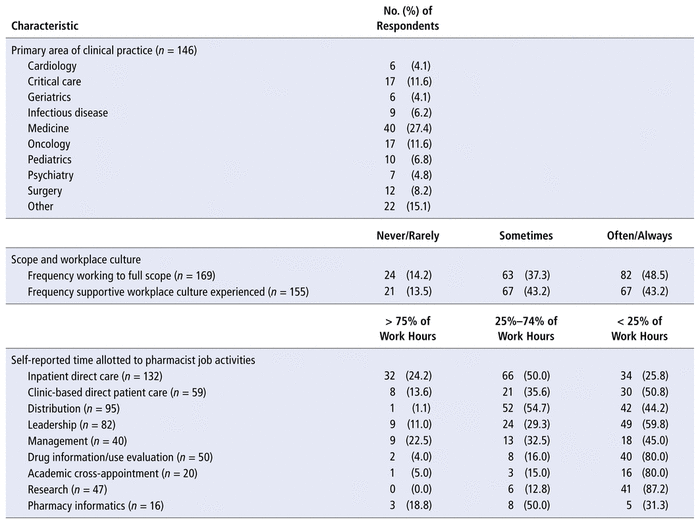
TABLE 3 Summary of Workplace Experiences of Canadian Hospital Pharmacists
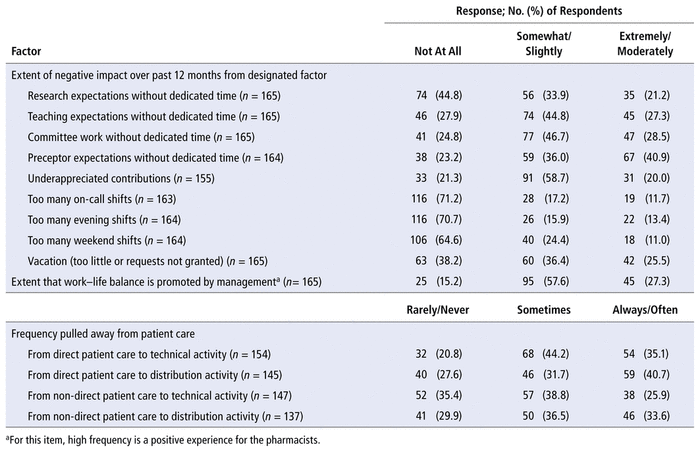
Scores for the individual subscales, defined according to the previously mentioned thresholds, are shown in Table 4. More than half of the respondents (61.4%, 105/171) met the burnout threshold on the emotional exhaustion subscale, 19.9% (34/171) met the burnout threshold on the depersonalization subscale, and 20.5% (35/171) met the burnout threshold on the personal accomplishment subscale. Internal consistency for the MBI-HSSMP subcategories was assessed using the Cronbach α and were found to be moderate to high (α = 0.92 for emotional exhaustion subscale, α = 0.73 for depersonalization subscale, and α = 0.79 for personal accomplishment subscale).
TABLE 4 Results for Canadian Hospital Pharmacists on Maslach Burnout Inventory Human Services Survey for Medical Personnel
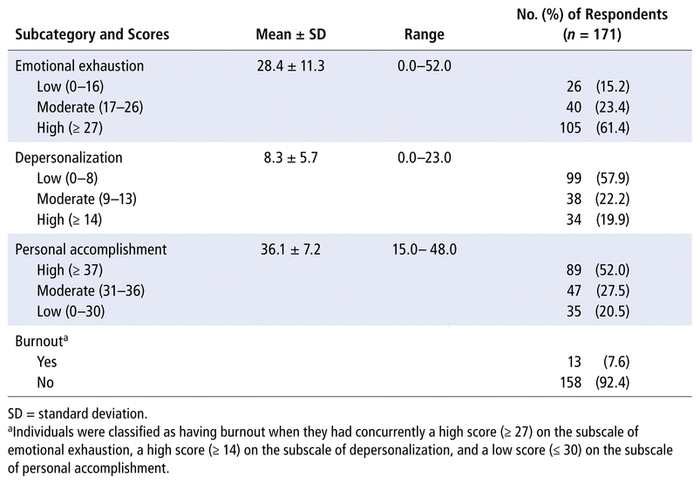
We first determined the relationship between employment characteristics and burnout status using the small sample of individuals (n = 13) who met the cut-off for burnout on all 3 subscales of the MBI. The only significant variable was the frequency of working to full scope of practice (Fisher exact test, p = 0.001, Benjamini–Hochberg critical value = 0.003, Cramer V = 0.33 [95% CI 0.21 to 0.48]), and none of the pharmacists who reported that they “often” or “always” worked to their full scope of practice experienced burnout. No other demographic or employment characteristics were found to be associated with burnout in this analysis.
We then performed a hierarchical linear regression to identify factors associated with burnout on the emotional exhaustion subscale of the MBI. Demographic information was included in block 1, with pharmacy job factors, professional impacts, and workplace factors in blocks 2, 3, and 4, respectively. The final regression model to identify factors associated with scores on the emotional exhaustion subscale was significant (R2 = 0.50, R2adj = 0.34, F(33, 105) = 3.12, p < 0.001). Not disclosing gender and indicating a greater self-reported negative personal impact of working too many on-call shifts were associated with higher scores on the emotional exhaustion subscale of the MBI-HSSMP (gender not disclosed: B = 13.89, 95% CI 2.22 to 25.56, standard error [SE] = 5.89, β = 0.19, p = 0.020, reference category = male gender; too many on-call shifts [with negative impact ranging from “not at all” to “extremely”]: B = 2.24, 95% CI 0.40 to 4.09, SE = 0.93, β = 0.24, p = 0.018). The pharmacist’s clinical area of practice (specifically, working in critical care or in other [uncategorized] practice areas) and more frequently experiencing a supportive workplace culture were both associated with lower scores on the emotional exhaustion subscale of the MBI-HSSMP (working in critical care: B = −9.64, 95% CI −15.74 to −3.54, SE = 3.08, β = −0.29, p = 0.002, and working in practice areas classified as “other”: B = −7.42, 95% CI −13.21 to −1.63, SE = 2.92, β = −0.24, p = 0.012, reference category = medicine; supportive workplace culture: B = −5.85, 95% CI −8.04 to −3.66, SE = 1.11, β = −0.47, p < 0.001). The addition of pharmacy job factors, professional impacts, and workplace factors to the regression model (blocks 2–4) explained an additional combined 36.0% of the variance in the emotional exhaustion subscale beyond demographic information (block 1 R2 = 0.14, R2adj = 0.04, F(14, 124) = 1.39, p = 0.17).
In all, 56.7% of individuals (97/171) responded to the open-ended question about burnout, providing a total of 594 responses. Three main themes were identified through discussion and consensus: workload quantity, workload quality, and workplace culture (remaining items were labelled as “Other” in the scoring process). The 2 coders independently categorized each item into one of these themes, and 89% agreement was obtained. For all items where disagreement occurred, consensus was achieved through discussion.
Overall, 44.4% (264/594) of the responses were categorized in the theme of workplace culture, 28.6% (170/594) in the theme of workload quantity, and 17.3% (103/594) in the theme of workload quality. Of the 97 pharmacists who provided responses to the open-ended question, 78 made at least 1 statement regarding workplace culture, 58 made at least 1 statement regarding workload quantity, and 42 made at least 1 statement regarding workload quality. Details about the content of the themes and examples of responses provided are presented in Table 5.
TABLE 5 Content Analysis of Open-Ended Responses
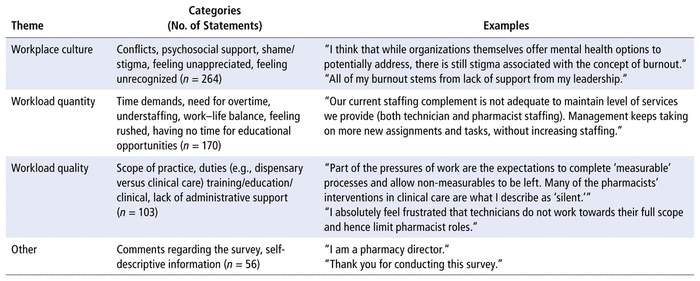
To our knowledge, this is the first study to assess the prevalence of burnout among hospital pharmacists across Canada, although a recent study surveyed pharmacists in Ontario on this topic.12 In the current study, we chose to look at burnout in 2 ways. First, we included all 3 subscales of the MBI-HSSMP (emotional exhaustion, depersonalization, personal accomplishment) when determining burnout, which yielded the relatively low burnout rate of 7.6%, a figure similar to those obtained by others2,11 using a similar approach. Second, we used only the emotional exhaustion subscale, as others have done22; the percentage of pharmacists categorized as having high scores on this subscale of the MBI-HSSMP was 61.4%, a rate slightly higher than the 53% observed previously in the United States3 and in Ontario.12 As noted by others,22 consensus is needed regarding whether a dichotomous criterion (burnout/no burnout) should be used (and if so, which subscales of the MBI-HSSMP should be used), or if using continuous subscale scores would be a superior approach, particularly for researchers.
In the present project, when all 3 subscales of the MBI-HSSMP were used to identify individuals experiencing burnout, univariate analyses suggested that the ability to work to full scope of practice may be a mitigating factor for burnout in pharmacists. One possible interpretation is that a definition of burnout involving high levels of both emotional exhaustion and depersonalization, as well as a low sense of personal accomplishment, may be more likely when pharmacists cannot fully focus on their clinical duties. As shown in Table 3, expectations to carry out nonclinical duties, such as preceptorship, committee work, and teaching, without dedicated time was frequently experienced negatively. Results from the content analysis further suggest that being able to work to full scope of practice is often hampered by insufficient pharmacy and administrative support. A sense of personal accomplishment may be difficult to achieve when doing tasks that could be completed by others on the pharmacy team. It is important to acknowledge that full scope of practice may be defined differently in different jurisdictions and by pharmacists with different roles in the hospital, such that the importance of clinical duties could be reduced for a minority of pharmacists.
The results obtained with a linear regression using the entire range of scores from the emotional exhaustion subscale support and extend the results of the univariate analyses. In the linear regression analysis, multiple variables were significant predictors of emotional exhaustion scores, including gender identity, perceived excessive on-call duties, and positivity of work culture. Although little research has been carried out on the role of gender identity in burnout among hospital employees, it has been found that workplace culture mediates the relationship between gender identity and job satisfaction.24 Thus, individuals not choosing male or female as their gender and those who feel that they are assigned excessive amounts of on-call duties may be experiencing higher levels of emotional exhaustion because they do not perceive their workplace as positive.
Finally, we also found that pharmacists working in certain practices such as critical care had lower levels of emotional exhaustion. While it is possible that individuals who choose this demanding work setting are better able to deal with high work demands, it is also possible that these practices are more likely to be adequately resourced, leading to a workplace that is perceived as more supportive. The question of whether different types of practices within the hospital are perceived by pharmacists to provide differentially supportive workplaces and to lead to different rates of burnout is a question that clearly deserves research attention. It remains however, that several factors that may contribute to a less supportive workplace culture have been associated with higher rates of burnout in previous research, including feelings that contributions were not appreciated,3,12 working with difficult colleagues,3,13 having too many nonclinical duties,3,8 and dissatisfaction with work–life balance.12
In the current study, more than half of respondents added open-ended responses to the survey’s final question. Although pharmacists were invited to comment on “feelings of exhaustion, negativism and reduced professional efficacy”, the most frequently used themes were workplace culture (e.g., conflict and feeling unappreciated) and workload quantity (e.g., understaffing and excessive workloads). As has been noted elsewhere,12 many interventions addressing burnout focus on the individual, but individuals are often powerless to make changes to reduce burnout without organizational support. In the present study, psychological dimensions did not emerge as key themes in the qualitative responses, which suggests that for these respondents, effective interventions will need to address organizational issues such as understaffing and excessive workloads, rather than individual coping skills. Possible interventions to mitigate distress could include full implementation of registered pharmacy technicians, assignment of balanced job responsibilities among staff, appropriate staffing levels, and recognition of the time demands of nonclinical tasks. It remains, however, that there is limited research, and limited support, to show that organizational-level interventions are successful in reducing burnout in health care professionals.25 Research to identify effective interventions to reduce burnout in pharmacy and other health care professions is needed.
Our study was limited by the small sample size and the low number of respondents meeting the threshold for burnout (defined on a dichotomous basis), which led to insufficient power to robustly test the association between a dichotomized definition of burnout and its hypothesized predictors using multivariate logistic regression. With the present data set, use of a linear regression approach with the scores on the emotional exhaustion scale was more feasible and informative. Hopefully, future studies will obtain larger samples with more variability on all 3 subscales, such that in-depth analyses can be carried out to determine, for example, whether different variables predict higher scores on different subscales of the burnout measure. Other possible limitations are that our survey was distributed primarily to hospital pharmacists who are members of the CSHP and was offered in English only. Moreover, the relatively low response rate suggests the possibility of selection bias if those who had experienced or were experiencing burnout were more (or less) likely to participate in the study.
The survey was distributed during the first few months of the COVID-19 pandemic, which might have affected both the content of the responses obtained and the response rate. Early research indicates that the pandemic has had deleterious effects on the well-being of pharmacists,16,17,26 even when they were not caring directly for patients with COVID-1916 and before they became involved in vaccination efforts.17 Given the continuing effects of the pandemic on the health care system, it is likely that data obtained during the first few months of the pandemic underestimate the amount of burnout experienced by hospital pharmacists. Further research should explore the effect of pandemic-related task changes on burnout, including the ability to work to full scope of practice, the potential increase in nonclinical duties, and increases in understaffing. A better understanding of the role of such task changes not only as predictors of burnout, but also as predictors of quality of care, job satisfaction, and turnover is vital to designing effective mitigation strategies to deal with the effects of the pandemic on pharmacists.
In this study of Canadian hospital pharmacists, relatively low rates of burnout were observed when burnout was defined on the basis of all 3 subscales of the MBI-HSSMP. However, when subscale scores and open-ended responses were analyzed, the results indicated that a substantial number of respondents were experiencing work-related distress. Further research is warranted to implement and test interventions to mitigate the negative work experiences of Canadian hospital pharmacists.
1 Maslach C, Jackson SE, Leiter, MP. Maslach burnout inventory manual. 3rd ed. Consulting Psychologists Press; 1996.
2 Durham ME, Bush PW, Ball AM. Evidence of burnout in health-system pharmacists. Am J Health Syst Pharm. 2018 1;75(23 Suppl 4):S93–S100.
Crossref PubMed
3 Jones GM, Roe NA, Louden L, Tubbs CR. Factors associated with burnout among US hospital clinical pharmacy practitioners: results of a nationwide pilot survey. Hosp Pharm. 2017;52(11):742–51.
Crossref PubMed PMC
4 Salvagioni DAJ, Melanda FN, Mesas AE, González AD, Gabani FL, Andrade SMD. Physical, psychological and occupational consequences of job burnout: a systematic review of prospective studies. PloS One. 2017;12(10):e0185781.
Crossref PubMed PMC
5 Shanafelt TD, Hasan O, Dyrbye LN, Sinsky C, Satele D, Sloan J, et al. Changes in burnout and satisfaction with work-life balance in physicians and the general US working population between 2011 and 2014. Mayo Clin Proc. 2015;90(12):1600–13.
Crossref PubMed
6 Poghosyan L, Clarke SP, Finlayson M, Aiken LH. Nurse burnout and quality of care: cross-national investigation in six countries. Res Nurs Health. 2010;33(4):288–98.
Crossref PubMed PMC
7 Salyers MP, Bonfils KA, Luther L, Firmin RL, White DA, Adams EL, et al. The relationship between professional burnout and quality and safety in healthcare: a meta-analysis. J Gen Intern Med. 2017;32(4):475–82.
Crossref PMC
8 Golbach AP, McCullough KB, Soefje SA, Mara KC, Shanafelt TD, Merten JA. Evaluation of burnout in a national sample of hematology-oncology pharmacists. JCO Oncol Pract. 2021 Nov 18:OP2100471.
9 Shoorideh FA, Ashktorab T, Yaghmaei F, Majd HA. Relationship between ICU nurses’ moral distress with burnout and anticipated turnover. Nurs Ethics. 2015;22(1):64–76.
Crossref
10 Shanafelt TD, Balch CM, Bechamps G, Russell T, Dyrbye L, Satele D, et al. Burnout and medical errors among American surgeons. Ann Surg. 2010;251(6):995–1000.
Crossref
11 Muir PR, Bortoletto DA. Burnout among Australian hospital pharmacists. J Pharm Pract Res. 2007;37(3):187–9.
Crossref
12 Weichel C, Lee JS, Lee JY. Burnout among hospital pharmacists: prevalence, self-awareness, and preventive programs in pharmacy school curricula. Can J Hosp Pharm. 2021;74(4):309–16.
PubMed PMC
13 Gaither CA, Nadkarni A. Interpersonal interactions, job demands and work-related outcomes in pharmacy. Int J Pharm Pract. 2012;20(2):80–9.
Crossref PubMed
14 Waldman JD, Kelly F, Arora S, Smith HL. The shocking cost of turnover in health care. Health Care Manage Rev. 2004;29(1):2–7.
Crossref PubMed
15 Higuchi Y, Inagaki M, Koyama T, Kitamura Y, Sendo T, Fujimori M, et al. A cross-sectional study of psychological distress, burnout, and the associated risk factors in hospital pharmacists in Japan. BMC Public Health. 2016;16:Article 534.
Crossref PubMed PMC
16 Johnstone K, O’Reilly CL, Scholz B, Georgousopoulou EN, Mitchell I. Burnout and the challenges facing pharmacists during COVID-19: results of a national survey. Int J Clin Pharm. 2021;43(3):716–25.
Crossref
17 Bakken BK, Winn AN. Clinician burnout during the COVID-19 pandemic before vaccine administration. J Am Pharm Assoc (2003). 2021; 61(5):e71–e77.
Crossref
18 Gupchup GV, Lively BT, Holiday-Goodman M, Siganga WW, Black CD. Maslach Burnout Inventory: factor structures for pharmacists in health maintenance organizations and comparison with normative data for USA pharmacists. Psychol Rep. 1994;74(3 Pt 1):891–5.
Crossref PubMed
19 Lahoz MR, Mason HL. Burnout among pharmacists. Am Pharm. 1990;NS30(8):28–32.
Crossref PubMed
20 Maslach C, Jackson SE, Leiter MP. Maslach Burnout Inventory: manual. 4th ed. Mind Garden, Inc; 2018.
21 Amosun SL, Dantile ND. Are we graduating physiotherapists with the burnout syndrome: evaluating physiotherapy education at the University of the Western Cape. S Afr J Physiother. 1996;52(3):69–72.
22 Doulugeri K, Georganta K, Montgomery A. “Diagnosing” burnout among healthcare professionals: Can we find consensus? Cogent Med. 2016;3(1). DOI:10.1080/2331205X.2016.1237605
Crossref
23 Hsieh HF, Shannon SE Three approaches to qualitative content analysis. Qual Health Res. 2005;15(9):1277–88.
Crossref PubMed
24 Cancela, D, Hulsheger UR, Stutterheim SE. The role of support for transgender and nonbinary employees: perceived co-worker and organizational support’s associations with job attitudes and work behavior. Psychol Sex Orientat Gend Divers. 2022;9(1):49–57.
Crossref
25 Ruotsalainen JH, Verbeek JH, Mariné A, Serra C. Preventing occupational stress in healthcare workers. Cochrane Database Syst Rev 2015;4:CD002892
26 Jones AM, Clark JS, Mohammad RA. Burnout and secondary traumatic stress in health-system pharmacists during the COVID-19 pandemic. Am J Health Syst Pharm. 2021;78(9):818–24.
Crossref PubMed PMC
Competing interests: For activities not related to the study reported here, Heather Naylor received speaker payment for presenting at the Canadian Society of Hospital Pharmacists New Brunswick Branch Spring Education Session and payment from Otsuka for participating on drug advisory panels. No other competing interests were declared. ( Return to Text )
Funding: The Horizon Health Network Pharmacy Department provided funding to acquire rights for use of the Maslach Burnout Inventory™ – Human Services Survey for Medical Personnel. ( Return to Text )
Canadian Journal of Hospital Pharmacy, VOLUME 75, NUMBER 4, Fall 2022